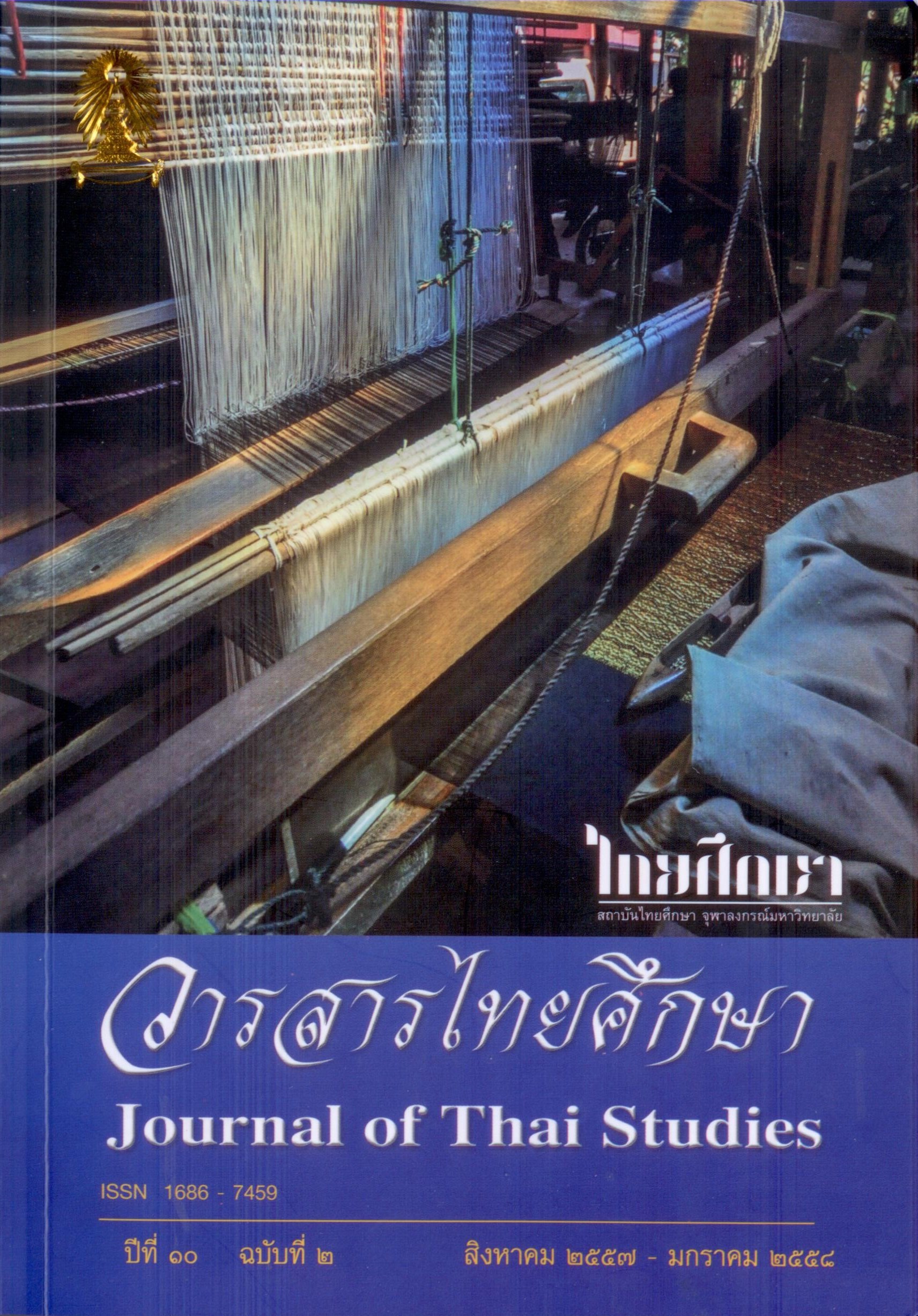The Role of Buddhist Monks and Novices with Respect to the Ten Thai Arts and Crafts during the Rattanakosin Period
Main Article Content
Abstract
The aim of this research article is to focus on the tradition and the role of Buddhist monks and novices with respect to the Ten Thai Arts and Crafts during Rattanakosin Period.
The research found that the role of monks and novices as related to arts and crafts work can be traced to the Tripitaka Buddhist Scriptures in the section of monastic disciplines or Vinaya Pitaka. There is evidence from the time of the Buddha that monks received the Buddha’s permission in conducting Navakam (construction) by themselves or supervising someone in the repair of five kinds of Senasana (lodgings): temples; central shrines; traditional thatched-roof houses; empty abodes or uninhabited spots; and caves – including the structural elements of door panels, windows, ceilings, moral paintings, stairs, arched entrances, beds, and stools. The role of monks and novices also included training in Navakam for laymen. Their roles in arts and crafts work developed onward to the Rattanakosin Period of Siam with prominent construction work in monasteries which has been codified into the Ten Arts and Crafts Work. The monk and novice’s craftsmanship includes the roles of craftsman, supervisor, instructor or trainer, disciple, and conservator pertinent to the monasteries. Through the study on traditional construction, some standardization has been developed institutionally into the system of the Non-Formal Education established in the Dhamma Studies School according to the ideas regarding educational management of Somdej Phra Thep Rattana Rajasuda Siam Boromraja Kumaree since 2007 until the present time (2014). This systematized direction has continuously maintained the connection between Buddhism and the Ten Arts and Crafts Work as a cultural inheritance in Thai society.
Downloads
Article Details

This work is licensed under a Creative Commons Attribution-NonCommercial-NoDerivatives 4.0 International License.
Journal of Thai studies is licensed under a Creative Commons Attribution-Noncommercial-NoDerivatives4.0 Intenational (CC BY-NC-ND 4.0) licence, unless otherwise stated. Plese read our Policies page for more information on Open Access, copyright and permissions.
References
คู่มือการถวายความรู้แด่พระสังฆาธิการสำหรับปีสืบสานวัฒนธรรมไทย ๒๕๓๘ - ๒๕๔๐ หลักสูตรการอนุรักษ์และพัฒนาศิลปกรรมของวัด. กรุงเทพฯ: สำนักงานคณะกรรมการวัฒนธรรมแห่งชาติ, ๒๕๓๙.
จิตรกรรมฝาผนังในกรุงเทพมหานคร ชุดที่ ๐๐๑/๒๕๓๓. กรุงเทพฯ: กองโบราณคดี กรมศิลปากร, ๒๕๓๓.
จุลทัศน์ พยาฆรานนท์. ร้อยคำร้อยความ. กรุงเทพฯ: สถาบันไทยศึกษา จุฬาลงกรณ์มหาวิทยาลัย, ๒๕๔๓.
เดลินิวส์ วันที่ ๑๗ สิงหาคม ๒๕๕๐.
ดำรงราชานุภาพ, สมเด็จกรมพระยา. ความทรงจำ. พระนคร: โรงพิมพ์ของสมาคมสังคมศาสตร์แห่งประเทศไทย, ๒๕๐๖.
น. ณ ปากน้ำ. พจนานุกรมศิลป์ ฉบับปรับปรุงใหม่. พิมพ์ครั้งที่ ๓ กรุงเทพฯ: สำนักพิมพ์เมืองโบราณ, ๒๕๓๐.
_____. พระอาจารย์นาค จิตรกรเอกยุคสร้างบ้านแปงเมือง. กรุงเทพฯ: สำนักพิมพ์เมืองโบราณ, ๒๕๓๐.
_____. ศิลปะรอบตัวเรา. กรุงเทพฯ: ต้นอ้อ, ๒๕๔๒
นริศรานุวัดติวงศ์, สมเด็จพระเจ้าบรมวงศ์เธอ เจ้าฟ้ากรมพระยา และดำรงราชานุภาพ, สมเด็จพระเจ้าบรมวงศ์เธอ. สาส์นสมเด็จ เล่ม ๑. พระนคร: คุรุสภา, ๒๕๐๕.
_____. สาส์นสมเด็จ เล่ม ๓. พระนคร: คุรุสภา, ๒๕๐๕.
_____. สาส์นสมเด็จ เล่ม ๑๖. พระนคร: คุรุสภา, ๒๕๐๕.
_____. สาส์นสมเด็จ เล่ม ๒๒. พระนคร: คุรุสภา, ๒๕๐๕.
ประชุมจารึกวัดพระเชตุพน. พิมพ์ครั้งที่ ๒ พระนคร: สำนักพิมพ์ผ่านฟ้าวิทยา, ๒๕๑๐.
ประวัติผู้ทรงคุณวุฒิทางศิลปะ เล่ม ๒. กรุงเทพฯ: กรมศิลปากร, ๒๕๒๙.
ประวัติวัดดุสิดารามวรวิหาร (ฉบับตรวจสอบชำระ). กรุงเทพฯ: กลุ่มบริษัทเกษม, ๒๕๔๐.
พจนานุกรมฉบับราชบัณฑิตยสถาน พ.ศ. ๒๕๔๒. กรุงเทพฯ: ราชบัณฑิตยสถาน, ๒๕๔๖.
พจนานุกรมฉบับราชบัณฑิตยสถาน พ.ศ. ๒๕๕๔. กรุงเทพฯ: ราชบัณฑิตยสถาน, ๒๕๕๖.
พจนานุกรมศิลปกรรม อักษร ก-ฮ ฉบับราชบัณฑิตยสถาน กรุงเทพฯ: ราชบัณฑิตยสถาน, ๒๕๕๐.
พระไตรปิฎกภาษาไทย ฉบับมหาจุฬาลงกรณราชวิทยาลัย เล่ม ๒. กรุงเทพฯ: มหาจุฬาลงกรณราชวิทยาลัย, ๒๕๓๙ (พิมพ์เฉลิมพระเกียรติสมเด็จพระนางเจ้าสิริกิติ์ พระบรมราชินีนาถ เนื่องในมหามงคลสมัยเฉลิมพระชนมพรรษา ๕ รอบ วันที่ ๑๒ สิงหาคม ๒๕๓๕)
พระไตรปิฎกภาษาไทย ฉบับมหาจุฬาลงกรณราชวิทยาลัย เล่ม ๗ กรุงเทพฯ: มหาจุฬาลงกรณราชวิทยาลัย, ๒๕๓๙ (พิมพ์เฉลิมพระเกียรติสมเด็จพระนางเจ้าสิริกิติ์ พระบรมราชินีนาถ เนื่องในมหามงคลสมัยเฉลิมพระชนมพรรษา ๕ รอบ วันที่ ๑๒ สิงหาคม ๒๕๓๕)
พระราชวรมุนี (ประยุทธ์ ปยุตฺโต), บทบาทของพระสงฆ์ในสังคมไทยปัจจุบัน.กรุงเทพฯ: การศาสนา, ๒๕๓๐. (คณะกรรมการอำนวยการจัดงานเฉลิมพระเกียรติพระบาทสมเด็จพระเจ้าอยู่หัว จัดพิมพ์เนื่องในพระราชพิธีมหากุศลเฉลิมพระชนมพรรษา ๕ รอบ ๕ ธันวาคม ๒๕๓๐.
รุ่งอรุณ กุลธำรง. รายงานวิจัยฉบับสมบูรณ์เรื่องวัฒนธรรมกรุงเทพมหานคร: การศึกษาวิชาช่างสิบหมู่สมัยกรุงรัตนโกสินทร์. กรุงเทพฯ: สำนักงานคณะกรรมการวัฒนธรรมแห่งชาติกระทรวงศึกษาธิการ, ๒๕๔๗ (อัดสำเนา).
_____. วัด: แหล่งอ้างอิงของแผ่นดินด้านวิชาช่างสิบหมู่สมัยรัตนโกสินทร์, วารสารไทยศึกษา ปีที่ ๕ ฉบับที่ ๑ (กุมภาพันธ์- กรกฎาคม ๒๕๕๒): ๑๑๘ – ๑๔๑.
ศรัณย์ ทองปาน. ชีวิตทางสังคมของช่างในสังคมไทยภาคกลางสมัยรัตนโกสินทร์. วิทยานิพนธ์หลักสูตรสังคมวิทยาและมานุษยวิทยามหาบัณฑิต สาขามานุษยวิทยา คณะสังคมวิทยาและมานุษยวิทยา มหาวิทยาลัยธรรมศาสตร์ ๒๕๓๔.
สมศักดิ์ สุขทิศ. ประวัติวัดแก้วพิจิตร. ปราจีนบุรี: กองทุนพิพิธภัณฑ์หอสมุดแห่งวัดแก้วพิจิตร, ๒๕๓๙.
สารานุกรมไทยฉบับราชบัณฑิตยสถาน เล่ม ๓. พระนคร: โรงพิมพ์รุ่งเรืองธรรม, ๒๔๙๙ - ๒๕๐๒.
เสฐียรโกเศศ. ชีวิตชาวไทยสมัยก่อน. กรุงเทพฯ: ราชบัณฑิตยสถาน, ๒๕๑๐.
______. วัฒนธรรมและประเพณีต่างๆ ของไทย. พระนคร: คลังวิทยา, ๒๕๑๔.
เอกสารประกอบการสัมมนาทางวิชาการเรื่อง บทบาทของพระสงฆ์: ผู้นำสังคมในการอนุรักษ์มรดกศิลปวัฒนธรรมไทย. จัดโดยสำนักเสริมศึกษาและบริการสังคม มหาวิทยาลัยธรรมศาสตร์วันที่ ๘ ธันวาคม ๒๕๓๔ ณ มหาวิทยาลัยธรรมศาสตร์.


